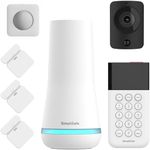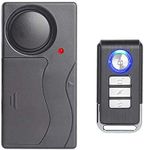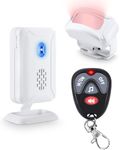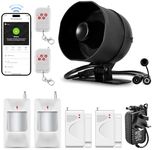Buying Guide for the Best Garage Alarm
Choosing the right garage alarm system is crucial for ensuring the security of your property and peace of mind. A good garage alarm system can deter intruders, alert you to potential break-ins, and even integrate with other smart home devices. When selecting a garage alarm, it's important to consider various specifications to find the best fit for your needs. Here are some key specs to look out for and how to navigate them.Sensor TypeThe sensor type determines how the alarm detects intrusions. Common types include motion sensors, door/window sensors, and vibration sensors. Motion sensors detect movement within the garage, door/window sensors alert you when a door or window is opened, and vibration sensors detect physical tampering. Choose a sensor type based on the specific vulnerabilities of your garage. For example, if you have multiple entry points, door/window sensors might be ideal, while motion sensors are great for detecting movement inside the garage.
ConnectivityConnectivity refers to how the alarm system communicates with you and other devices. Options include Wi-Fi, cellular, and landline connections. Wi-Fi connectivity allows for easy integration with smart home systems and remote monitoring via smartphone apps. Cellular connectivity is reliable even if your internet goes down, while landline connections are more traditional but can be vulnerable if the phone line is cut. Choose a connectivity option based on your preference for remote access and reliability.
Power SourceThe power source of the alarm system can be battery-operated, hardwired, or solar-powered. Battery-operated systems are easy to install and maintain but require regular battery changes. Hardwired systems are more permanent and reliable but may require professional installation. Solar-powered systems are eco-friendly and can be a good option if your garage gets ample sunlight. Consider your garage's setup and your willingness to maintain the system when choosing the power source.
Alarm VolumeAlarm volume is the loudness of the alarm when it is triggered. Measured in decibels (dB), a higher volume can be more effective in deterring intruders and alerting you or your neighbors. Typical alarm volumes range from 85 dB to 120 dB. Choose a volume level that is loud enough to be heard from a distance but not so loud that it causes unnecessary disturbance. Consider the size of your property and proximity to neighbors when selecting the alarm volume.
Smart FeaturesSmart features include integration with other smart home devices, remote monitoring, and control via smartphone apps. These features allow you to receive real-time alerts, arm/disarm the system remotely, and even view live video feeds if the system includes cameras. If you already have a smart home ecosystem or prefer the convenience of controlling your alarm system from your phone, look for a system with robust smart features.
InstallationInstallation can be DIY or professional. DIY systems are designed for easy installation and can save you money, but they may require some technical know-how. Professional installation ensures that the system is set up correctly and optimally, but it comes at an additional cost. Consider your comfort level with installing the system yourself and whether you prefer the assurance of professional installation.
ExpandabilityExpandability refers to the ability to add more sensors or components to the system in the future. A system with good expandability allows you to start with a basic setup and add more sensors, cameras, or other devices as needed. This is important if you anticipate needing more coverage or additional features down the line. Choose a system that offers flexibility and can grow with your security needs.















